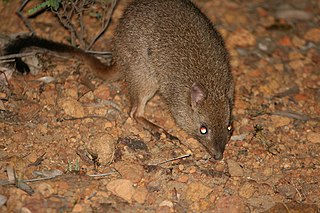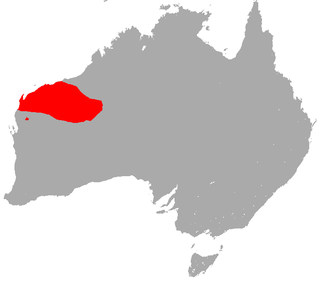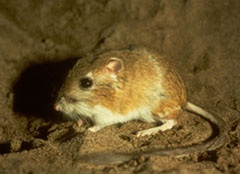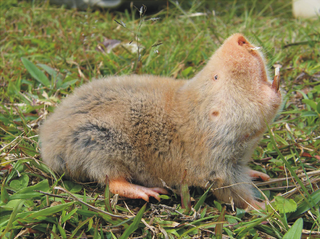
The kowari, also known by its Diyari name kariri, is a small carnivorous marsupial native to the gibber deserts of central Australia. It is the sole member of the genus Dasyuroides.

The bush rat or Australian bush rat is a small Australian nocturnal animal. It is an omnivore and one of the most common indigenous species of rat on the continent, found in many heathland areas of Victoria and New South Wales.

The woylie or brush-tailed bettong is a small, critically endangered mammal native to forests and shrubland of Australia. A member of the rat-kangaroo family (Potoroidae), it moves by hopping and is active at night, digging for fungi to eat. It is also a marsupial and carries its young in a pouch. Once widespread, the woylie mostly died out from habitat loss and introduced predators such as foxes. It is currently restricted to two small areas in Western Australia. There were two subspecies: B. p. ogilbyi in the west, and the now-extinct B. p. penicillata in the southeast.

Gould's mouse, also known as the Shark Bay mouse and djoongari in the Pintupi and Luritja languages, is a species of rodent in the murid family. Once ranging throughout Australia from Western Australia to New South Wales, its range has since been reduced to five islands off the coast of Western Australia.

Maclear's rat is an extinct large rat endemic to Christmas Island in the Indian Ocean. It was one of two species of rat native to Christmas Island, alongside the bulldog rat. Abundant, unfamiliar with and seemingly unafraid of humans, large numbers of the creatures emerged and foraged in all directions at night. Making querulous squeaks, the rats entered the Challenger expedition's tents and shelters in 1886, ran over sleepers, and upset everything in the search and fight for food. Maclear's rat might have been responsible for keeping the population of the Christmas Island red crab in check, as recent numbers of the crab are greater than in the past. It is thought that black rats inadvertently introduced by the expedition infected the Maclear's rats with a disease, which in turn could have contributed to the species' decline. The last recorded sighting was in 1903, although it is possible that Maclear's rats hybridized with black rats. A hard tick, described as an ectoparasite of Maclear's rat, is also thought to be extinct.

The Australian swamp rat, also known as the eastern swamp rat, is a species of rat native to the coasts of southern and eastern Australia.

The little red kaluta is a small, reddish-brown, shrew-like mammal native to dry grasslands of northwest Australia. It is active at night, feeding on insects and other small animals. The kaluta is a marsupial and is the only member of its genus, Dasykaluta. Individuals are around 10 cm (3.9 in) long and weigh from 20 to 40 g. They live for about four years in captivity. Other common names include little red antechinus, russet antechinus and spinifex antechinus.

Ord's kangaroo rat is a kangaroo rat native to western North America, specifically the Great Plains and the Great Basin, with its range extending from extreme southern Canada to central Mexico.

The golden bandicoot is a short-nosed bandicoot found in northern Australia. It is the smallest of its genus, and is distinguished from the brown bandicoots by its golden colouring and much smaller size.

The spectacled hare-wallaby is a species of macropod found in Australia and New Guinea. In Australia, a small sub-population is found on Barrow Island, while the mainland type is widespread, though in decline, across northern regions of the country.

The short-eared rock-wallaby is a species of rock-wallaby found in northern Australia, in the northernmost parts of the Northern Territory and Western Australia. It is much larger than its three closest relatives, the eastern short-eared rock-wallaby, the nabarlek and the monjon.

The monjon is the smallest species of rock-wallabies (Petrogale) and is found in north-west Australia. They are restricted to a small area of the Kimberley region and on nearby islands in the Bonaparte Archipelago. Common names also include Burbidge's rock-wallaby and Burbidge's rock-weasel.

Nabarleks, are a tiny species of macropod found in northern Australia. They are a shy and nocturnal animal that resides in rocky hollows and forages in the surrounding area. Their diet is grasses, sedges, and ferns found in and around their scrub covered refuges. They are distinguished by a reddish tinge to the mostly grey fur and a distinct stripe at the cheek. They move with great speed and agility when observed, with a forward leaning posture and a bushy tail that arches over the back.

The heath mouse is a species of mouse in the subfamily Murinae, the Old World rats and mice, found in Australia.

The silvery mole-rat, silvery blesmol, or silky mole-rat is a species of mole-rat of East Africa which occurs in southern Kenya, Tanzania, southeastern Democratic Republic of Congo, Mozambique and Malawi. Solitary and aggressive, little is known about its ecology or behavior. It is monotypic in the genus Heliophobius. A common species, the International Union for Conservation of Nature has rated it as being of "least concern".

The greater stick-nest rat, also known as the housebuilding rat and wopilkara, is a species of rodent in the family Muridae. They are about the size of a small rabbit and construct large nests of interwoven sticks. Once widespread across southern Australia, the population was reduced after European colonisation to a remnant outpost on South Australia's Franklin Islands. The species has since been reintroduced to a series of protected and monitored areas, with varying levels of success.

The long-haired rat, is a species of rodent in the family Muridae which is native to Australia. The long-haired rat is well known for its population irruptions over vast areas of Australia which is the basis of its alternative common name, the plague rat. Most of the research on the long-haired rat has been conducted during times of massive population fluctuations and therefore little is known about their biology in a non-eruptive period.

The Christmas Island shrew, also known as the Christmas Island musk-shrew is an extremely rare or possibly extinct shrew from Christmas Island. It was variously placed as subspecies of the Asian gray shrew or the Southeast Asian shrew, but morphological differences and the large distance between the species indicate that it is an entirely distinct species.

Rattini is a very large, diverse tribe of muroid rodents in the subfamily Murinae. They are found throughout Asia and Australasia, with a few species ranging into Europe and northern Africa. The most well-known members of this group are the true rats, several species of which have been introduced worldwide.




















